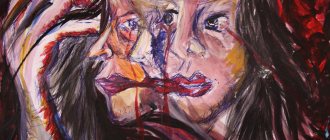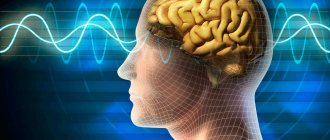This form of schizophrenia is considered a borderline state between the continuous and paroxysmal course of the disease. It is the most common type of illness and can begin in early or teenage years. At the initial stages, the manifestations of the disorder are not so pronounced, but as fur-like schizophrenia progresses, the symptoms worsen. Specialists at the Leto specialized clinic will be able to recognize specific signs of the disease, make an accurate diagnosis and select appropriate therapy. If there is a need for round-the-clock medical supervision, we offer hospitalization in our hospital, where rooms of various levels of comfort are equipped.
Characteristics of the disorder
Schizophrenia takes its name from the German word schub, which means “shift.” We are talking about a personal shift, a developmental turning point that is irreversible. A persistent mental defect is formed, causing gross distortion of the personality.
Paroxysmal-progressive or fur coat-like schizophrenia is characterized by alternating attack periods with remission phases. The duration and severity of symptoms in both phases depends on the form of the disorder, as well as the stage of the disease.
Attacks or fur coats can be marked by a sudden, acute development, appearing over several days, or have a subacute course, when symptoms increase over several weeks. The attack lasts from several weeks to several months.
Remissions have varying degrees of severity. The first psychotic attack, as a rule, ends in complete remission, without defective traces. The patient retains a critical attitude towards the behavior and experiences suffered during psychosis, or forgets its picture completely. However, as the course of remission progresses, it loses its benign quality and becomes incomplete, expressing persistent personal changes.
Usually the defect appears clearly after 3-4 psychotic attacks. The duration of remission ranges from several weeks to several years. Their quality is influenced by the therapy applied to the disorder. Interruption of treatment leads to a reduction in remissions and an increase in the intensity and duration of psychosis.
With the increase in personal shift, the course of the disease changes, more reminiscent of a continuously flowing form with attack periods. Continuity is determined by the presence, even during the interictal, remission, period of negative symptoms of schizophrenia: lethargy, apathy, physical inactivity, emotional coldness, isolation, thinking disorders, with the appearance of bright psychotic outbursts against their background.
This form of the disorder is considered the most common among all existing schizophrenic types. The outcome of the disease is ambiguous. In the case of a malignant course, the patient’s psychotic defect rapidly increases, causing the formation of schizophrenic dementia. The clinical picture, similar to the sluggish form, provokes the emergence of a shallow disintegration of the personality. More often, an intermediate state between two extreme options is formed.
Kandinsky-Clerambault syndrome
With this syndrome, patients feel that their thoughts, feelings or actions belong to other individuals. It’s as if it’s not them who speak or move their hand, but another person who does it.
Such symptoms are called automatisms. There can be several types:
- Ideatorial (associative). Characterized by the belief that a person’s thinking is influenced by someone else. One of the common variants of this automatism is mentism, in which a person cannot control ideas and memories. It seems to him that they are involuntary. Sometimes there is a syndrome of openness, when the patient believes that all his thoughts are known to those around him, who discuss him in secret. The same group of automatisms should include unintelligible noises, internal monologues and sentences, disappearance of ideas and memories, etc.
- Sensory (senestopathic). The patient develops painful sensations of a somatic nature. He becomes either hot or cold, and pain occurs in the limbs or internal organs. The main thing is that it seems to the patient that all these symptoms are a consequence of the influence of extraneous forces on him. There are sensations of pulsation, twisting, squeezing, bursting, etc.
- Motor (kinesthetic). The patient believes that all his movements are performed not by himself, but by some other person. It “forces” a person to move, speak, and perform certain actions. Feelings of numbness and paralysis are possible.
The described automatisms, as a rule, develop in exactly this sequence. First, ideomotor ones appear, then sensory ones, and then motor ones.
What precedes the disease
The first signs indirectly indicating the development of fur coat-like schizophrenia can be noted in early childhood. Children develop according to the principle of a schizoid personality. They are withdrawn, prefer loneliness, and are emotionally cold. There may also be a deficit in the energy and intellectual spheres.
The picture of the pre-manifest, preceding period of the disorder is characterized by fears, obsessive thoughts and actions, a depressed state, and despondency. Subsequently, during crisis periods of age, outbreaks of psychopathological symptoms were observed that did not cause persistent personality changes. These include hypochondria, depression, social withdrawal, anxiety and tension, unusual train of thoughts, some demonstrativeness, aggression, weakening of will.
Example: Tatyana, 28 years old, suffers from fur coat-like schizophrenia. Psychomotor development up to 3 years of age is without any peculiarities. At the age of three I went to kindergarten, but had difficulty adapting to the children's group and cried constantly. She didn’t share toys, she played alone, alone. Soon she stopped attending preschool.
In the first grade there were also problems with adaptation. The girl's behavior was restless and she did not want to study. Subsequently, in further classes, the situation changed a little for the better. I began to excel in my studies.
She had formal relationships with her peers. She was shy and touchy. She considered herself super smart. She said that she sees right through other children. I was interested in psychology. I conducted tests with classmates and gave advice.
There were outbursts of sudden irritation, during which she hit her classmates with whatever came to hand.
The initial, that is, the initial period of the disease, is marked by an increase in the severity of pre-manifest symptoms of fur-like schizophrenia, and occurs approximately two years before the first attack of the disorder.
Acute hallucinosis
Acute hallucinosis is another variant of exacerbation of paranoid schizophrenia. Symptoms are very varied:
- Verbal illusions
- "Other people's speeches" in my head
- Classic hallucinations
- Internal dialogues that the patient listens to from the outside
- Multiple voices
- Mental automatisms, etc.
With further progression of the pathology, paraphrenia develops, which is accompanied by fantastic hallucinations. The patient may believe that he has superpowers and can influence other people or the world around him with their help.
The degree of personality changes in the paranoid type of fur coat-shaped schizophrenia can be different. In any case, the treatment will be difficult and lengthy.
Attack period
The clinical picture of the attack phase of the disorder is very diverse.
It is distinguished by the presence of psychopathic, depersonalization, hallucinatory, delusional and other syndromes. The depressive signs of the psychotic phase of the disease are characterized by lethargy, decreased activity, but without a feeling of melancholy. There is a depressed, gloomy mood, aggressiveness, and hostility towards others. Patients are irritable and have outbursts of anger. Hypochondriacal thoughts are also characteristic.
Often, against the background of depression, a paranoid syndrome develops, manifested by delusions of various directions: persecution, poisoning, greatness, relationships, special purpose. The patient shows excessive suspicion and distrust towards those around him. There is no critical attitude towards delirium. Severe thinking disorders are observed.
Manic episodes are also common in this form of schizophrenia. Characterized by more motor rather than intellectual excitement. Typically speech agitation, fruitless philosophizing.
The phenomena of depersonalization are associated with a feeling of one’s own change. They arise against the background of erased depression. Accompanied by a change in perception of the surrounding world, isolation, and decreased activity.
A 13-year-old patient describes her condition: “I began to clearly feel changes in myself, not happening abruptly, but gradually. It wasn't depression. I don’t even know if this is a disease or normal. Inexplicable depression appeared and there was no desire to do anything. I wanted solitude, to be alone with my thoughts. I talked a lot about death and suffering.” The girl justified the changes in her sense of self as adolescence, which is accompanied by a change in values and priorities.
Psychopathic-like disorders are more characteristic of adolescence and are called heboid. Typical traits are rudeness, irritability and opposition to control. There is a marked decrease in volitional activity. While maintaining intellectual abilities, patients lose the ability to learn and work. Metaphysical intoxication is characteristic - useless reasoning on high, philosophical topics. Self-control is impaired, which often provokes sexual liberation, alcohol and drug addiction.
It should be noted that there is no withdrawal syndrome in schizophrenic patients with addictions. When the schizophrenic furnace lasts for years, patients receive a persistent moral and emotional personality defect. However, with age, psychopathic manifestations smooth out, leaving a slight infantile effect. Patients become able to master certain professions and start a family.
More severe forms of the disease are accompanied by pronounced Kandinsky-Clerambault syndrome and catatonic-hebephrenic phenomena.
Kandinsky-Clerambault syndrome is distinguished, first of all, by delusions of physical influence, as well as mental automatisms, manifested by a feeling of unnaturalness, alienness of one’s own actions, thoughts, and sensations.
Catatonic-hebephrenic symptoms mark a particularly severe course of the disease. Hebephrenia is manifested by motor agitation, foolishness, stereotypies, and importunity. Patients make chaotic, pretentious, impulsive movements. They are verbose, but their speech is characterized by incoherence and incomprehensibility. Shout out individual phrases or words.
Excitement is replaced by a catatonic stupor, accompanied by typical manifestations: waxy flexibility, silence, immobility, negativism.
A 25-year-old girl was admitted to the department of a psychiatric hospital. The patient's condition is characterized by a sharp change in mood: she sometimes cries, sometimes laughs, and is polite to the doctors. Doesn't respect subordination. Declares his love to all males, including patients. Expresses persistent thoughts of suicide because no one loves her. After therapy she was discharged.
A year later he is re-admitted to the department. I took 50 tablets of diphenhydramine: this is what Mayakovsky’s voice ordered, having the best intentions. The poet visited the sick room with Yesenin and Tsvetaeva. Together they discussed suicide. The patient talks about the meaninglessness of life. There is no self-criticism. She wanted to commit suicide in the manner of Tsvetaeva, adhering to the principle of the last straw.
Malignant fur coat-like schizophrenia
Malignant schizophrenia begins as a fur-like disorder, that is, it consists of alternating attacks and remissions. But later the pathology becomes persistent. A schizophrenic defect is observed. There is a possibility of death.
First, a person’s mood disappears and his overall energy potential decreases, which is accompanied by inactivity. The patient does not want to do anything, is not interested in anything, and shows less and less emotion. But this is only the period preceding the attack.
The disease itself begins with hypomania, a condition that is similar to mania, but not as pronounced. Euphoria periodically increases, the person behaves foolishly. There is hostility towards loved ones and others. Symptoms of subdepression are observed when the patient becomes lethargic and irritable, and often thinks about death and suicide.
In general, the symptoms are very severe. To one degree or another, the following signs of the course of malignant fur coat-like schizophrenia may be observed:
- Delusions and hallucinations. Pseudohallucinations are possible when the patient does not identify visible or audible objects with real ones
- Catatonia is a type of movement disorder. There can be both stupor and excitement
- Paranoid syndrome. The patient is delusional, draws various conclusions that have no basis, provides contradictory evidence, etc. All this is interspersed with hallucinations
- Oneiric syndrome is a clouding of consciousness with an influx of fantastic hallucinations that mix with reality, and sometimes simply displace it
- Mutism is a painful condition in which a person cannot answer questions and does not even let others know that he is ready to contact them.
Along with these symptoms, bullous dermatitis, toxicosis and elevated body temperature are observed. The disease requires emergency hospitalization. Over the years, the attacks will be longer and longer, and the remissions will be short, until delusions and hallucinations completely displace the “healthy” personality.
Often this form of pathology occurs in adolescence and young adulthood. In severe cases, drug therapy does not produce any results. The patient may die.
Unlike juvenile schizophrenia (also a rather complex disease), malignant fur coat is manifested by the patient’s ability to realize his altered state. He has the opportunity to contact others and perform simple work activities.
Remission
The signs accompanying the interictal period of fur coat-like schizophrenia are also divided into productive, negative, and psychopathological.
Accompanied by the following manifestations:
- productive – a feeling of change in one’s own personality, an overvalued attitude towards one’s condition. Mistrust, suspicion. Paralogical thinking. The presence of strange ideas of a mystical, religious nature. Lack of semantic connections of speech;
- negative – lethargy, decreased activity. Loss of interest in any type of activity, its automatic implementation. Rigidity in relationships with other people, alienation, passivity. Lack of motivation to activity. Poor speech and facial expressions appear. Emotional poverty and social isolation are growing. The understanding of abstract expressions and figurative meanings is lost. The statements are broken and paradoxical. There is unproductiveness of social interaction;
- psychopathological – pathological focus on oneself, one’s own health. Touchiness, demand for attention and care. Detachment from others, loneliness. Reduced volitional efforts. Increased irritability, grumpiness, negativism. The presence of fantastic thoughts, extremely valuable ideas of persecution. Remission in severe cases of the disease is accompanied by delusions and hallucinations. Decreased self-control and self-criticism. Characterized by negativism, aggression, impulsiveness, stereotyping and pretentious movements. Low contact, inability to carry out work activities.
Interpretive nonsense
Interpretive delusion, along with the syndrome described above, is one of the types of exacerbations of the paranoid course of fur-like schizophrenia. Delusional thoughts and ideas can haunt a person for years, but before an exacerbation, a person experiences anxiety for no reason and sudden mood swings. In the acute phase, there may be automatisms and hallucinations - auditory, visual and olfactory. Other signs of interpretive delusion are:
- Sustained systematized delirium
- Delusional thoughts are associated with persecution, jealousy, invention and physical abuse
- From the outside, personal changes become noticeable
- Inappropriate facial reactions (or their complete absence)
The patient's professional skills do not suffer, and his memory does not fail. However, thinking is impaired, which prevents full-fledged work activity.
Causes
The causes of any form of schizophrenia, as an object of study, remain open. Doctors and scientists talk about predisposing factors, including intrauterine anomalies, drug addiction, alcoholism, congenital diseases of the central nervous system and genetic predisposition. But the exact causes and mechanism of development of schizophrenia are still unknown to science.
Pathology is detected in both men and women, but in the latter, symptoms usually appear 6 years later. The main symptoms are observed between the ages of 20 and 30 years.











